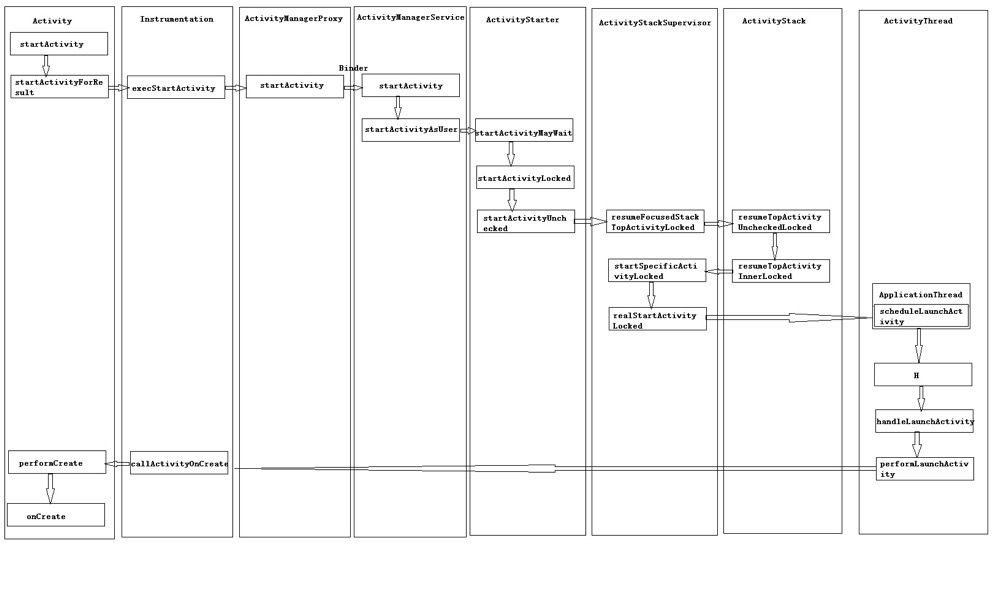Activity

startActivity
1 |
|
startActivityForResult
1 | public void startActivityForResult(@RequiresPermission Intent intent, int requestCode) { |
我们直接看mParent == null就行了,下面的已经是远古级别了,已经被fragment淘汰,暂且不论。前者关键方法mInstrumentation.execStartActivity(),返回回调结果。Instrumentation拿来测试过的同学并不陌生,这里且当它是个黑科技工具。
execStartActivity
1 | public ActivityResult execStartActivity( |
- who:正在启动该Activity的上下文
- contextThread:正在启动该Activity的上下文线程,这里为ApplicationThread
- token:正在启动该Activity的标识
- target:正在启动该Activity的Activity,也就是回调结果的Activity
checkStartActivityResult
1 | public static void checkStartActivityResult(int res, Object intent) { |
这些异常你都见过吗?它就是根据返回码和intent抛出相应异常,最熟悉的就是activity没有在AndroidManifest里面注册了。这其实不是我们今天要讲的关键,在这个方法中,我们还发现了熟悉的字眼startActivity,但调用者却很陌生ActivityManagerNative.getDefault(),这到底是什么玩意?
ActivityManagerNative.getDefault()
1 | static public IActivityManager getDefault() { |
这样看下来好像是ServiceManager构建了一个key为activity的对象,该对象作为ActivityManagerProxy的参数实例化创建单例并get返回。这里先不作解析,继续连接上面的流程ActivityManagerNative.getDefault().startActivity(…)。我们已经知道startActivity方法其实是ActivityManagerProxy调的,我们再来看看。
ActivityManagerProxy.startActivity
1 | public int startActivity(IApplicationThread caller, String callingPackage, Intent intent, |
如果对transact比较熟悉的话,那就很棒了,可以直接跳到下一节。不懂的同学继续,这里引入了Binder的概念,那么Android为什么要引入呢?这样说来ActivityManagerProxy是不是个代理类啊?为什么要引入,我不正面回答,假如我们要跨进程服务通信,你是不是先创建一个xx.aidl文件,然后会自动生成一个xx.java文件。你有没有仔细看过里面的内容呢?没看过的可以去看看。你会发现惊人的相似,如果是同一进程,我相信没人会这么做吧?从这些我们平时的开发经验来看,这玩意貌似用在跨进程通信上,就上面栗子来说,我们可以通过Service返回的Binder(其实就是个代理类)调用远程的方法,我们的Activity相当于客户端,而Service相当于服务端,这里也是一样,代理类就是ActivityManagerProxy。而真正传输数据的是mRemote.transact,简单介绍下,第一个参数code是告诉服务端,我们请求的方法是什么, 第二个参数data就是我们所传递的数据。这里比较纠人的是为什么要跨进程?这个你得了解下应用的启动过程了,这里我针对本篇文章简单的科普一下,应用启动会初始化一个init进程,而init进程会产生Zygote进程,从名字上看就是一个受精卵,它会fork很重要的SystemServer进程,比较著名的AMS,WMS,PMS都是这玩意启动的,而我们的应用进程也是靠AMS通信告诉Zygote进程fork出来的,因此需要跨进程通信,顺便解答下上面没回答的问题,ServiceManager构建的就是我们传说中的AMS。花了比较长的篇幅介绍Binder,也是无奈之举,帮助你们理解,但只是简单的介绍,有些细节并没有介绍,大家大可文外系统化地了解,很复杂,嘿嘿。
ActivityManagerService
startActivity
通过代理类ActivityManagerProxy调用了startActivity方法,让我们来搜寻一下AMS的startActivity方法。1
2
3
4
5
6
public final int startActivity(IApplicationThread caller, String callingPackage,
Intent intent, String resolvedType, IBinder resultTo, String resultWho, int requestCode,
int startFlags, ProfilerInfo profilerInfo, Bundle bOptions) {
return startActivityAsUser(caller, callingPackage, intent, resolvedType, resultTo,resulUserHandle.getCallingUserId());
}
- caller:就是我们的whoThread,见Instrumentation参数分析
- callingPackage:包名
- intent:意图
- resolvedType:就是我们AndroidManifest注册时的MIME类型
- resultTo:就是我们的token,见Instrumentation参数分析
- resultWho:就是我们target的id
- requestCode:这个就不说了
- startFlags:启动标志,默认传0
- profilerInfo:默认传null
- options:略过
由于篇幅过长,接下来可能不会仔细分析参数,请大家顺着参数的走向或者参数名理解。
AMS的startActivity方法什么都没做,直接调了startActivityAsUser方法,我们来看看这是什么东西?
startActivityAsUser
1 |
|
其中enforceNotIsolatedCaller方法是检查是否属于被隔离的对象。mUserController.handleIncomingUser检查操作权限然后返回一个用户id(涉及到Linux,有兴趣的同学可以翻阅翻阅,这不是我们的重点),startActivityAsUser方法大概就是检测下权限,然后返回由mActivityStarter(ActivityStarter,可以这么说,关于Activity启动的所有信息都在这了,然后根据信息把Activity具体分配到哪个任务栈)调用的startActivityMayWait方法。
继续跟踪ActivityStarter的startActivityMayWait的方法。
startActivityMayWait
1 | final int startActivityMayWait(IApplicationThread caller, int callingUid, |
mSupervisor(ActivityStackSupervisor)简单来说就是用来管理ActivityStack的,后来新增的。resolveIntent和resolveActivity方法用来确定此次启动activity信息的。关于heavy(ResolveInfo)涉及到重量级进程(SystemServer, MediaServer,ServiceManager),如果当前系统中已经存在的重量级进程且不是即将要启动的这个,那么就要给Intent赋值。接下来继续走我们的探索之路startActivityLocked。
startActivityLocked
1 | final int startActivityLocked(IApplicationThread caller, Intent intent, Intent ephemeralIntent, |
callerApp ,sourceRecord,resultRecord是当中比较关键的变量,但都是为变量r服务,因为它记录着整个方法杂七杂八的各种判断结果,然后带着变量r调用startActivityUnchecked方法,继续跟进。
startActivityUnchecked
1 | private int startActivityUnchecked(final ActivityRecord r, ActivityRecord sourceRecord, |
这个方法相对重要,但还不是重头戏,先看setInitialState,
setInitialState
1 | private void setInitialState(ActivityRecord r, ActivityOptions options, TaskRecord inTask, |
这里初始化了比较重要的mStartActivity,mIntent,mCallingUid,mSourceRecord,mLaunchFlags。mLaunchFlags用来记录我们Activity的启动方式,省略部分都是根据启动方式来初始化一堆变量或进行操作。下面的方法computeLaunchingTaskFlags还是用来初始化启动标志位的,我的天!真正初始化启动方式标志位后进行设置mIntent.setFlags(mLaunchFlags)。初始化启动方式后,那么我们需要初始化Tack了,如果对启动模式有了解的同学下面的就比较好理解了,在getReusableIntentActivity方法中,我们需要去找一个可复用的ActivityRecord,那么只有启动模式为SingleInstance才能真正的复用,因为整个系统就只有一个实例。这里也列举了相邻地启动同一个Activity的情况,为什么有这种情况呢?感兴趣的同学可以试试(主要还是考验启动模式的理解)。startActivityUnchecked方法细说真的是三天三夜都说不完。继续看下面的方法吧。
startActivityLocked
1 | final void startActivityLocked(ActivityRecord r, boolean newTask, boolean keepCurTransition, |
mWindowManager.setAppVisibility(r.appToken, true);这句话表示这个Activity已经具备了显示的条件。接下来我们长话短说,大体来看已经差不多了,通知后,我们会调用ActivityStackSupervisor的resumeFocusedStackTopActivityLocked方法,接着调ActivityStack的resumeTopActivityUncheckedLocked方法,再调自己的resumeTopActivityInnerLocked方法,如果Activity已存在需要可见状态,那么会调IApplicationThread的scheduleResumeActivity方法,且经过一系列判断可见Activity;反之调ActivityStackSupervisor的startSpecificActivityLocked的方法,那么继续会调realStartActivityLocked的方法。
ActivityThread
终于调ApplicationThread的scheduleLaunchActivity方法啦!
scheduleLaunchActivity
1 |
|
看最后,熟悉的味道,handler发送message,那么这个handler是什么呢?有请天字第一号Handler,H。
H
1 | private class H extends Handler { |
handleLaunchActivity
我们直接看我们发的消息,它调用了ActivityThread的handleLaunchActivity方法。1
2WindowManagerGlobal.initialize();//初始化WMS
Activity a = performLaunchActivity(r, customIntent);//创建并启动
performLaunchActivity
1 | private Activity performLaunchActivity(ActivityClientRecord r, Intent customIntent) { |
1 | public Application makeApplication(boolean forceDefaultAppClass, |


